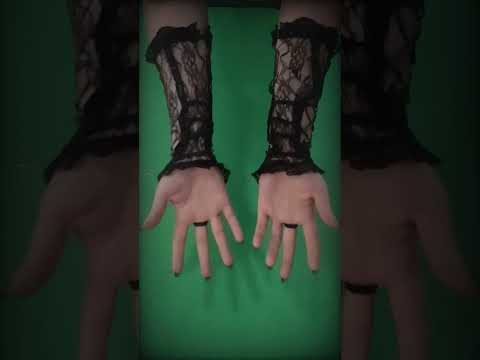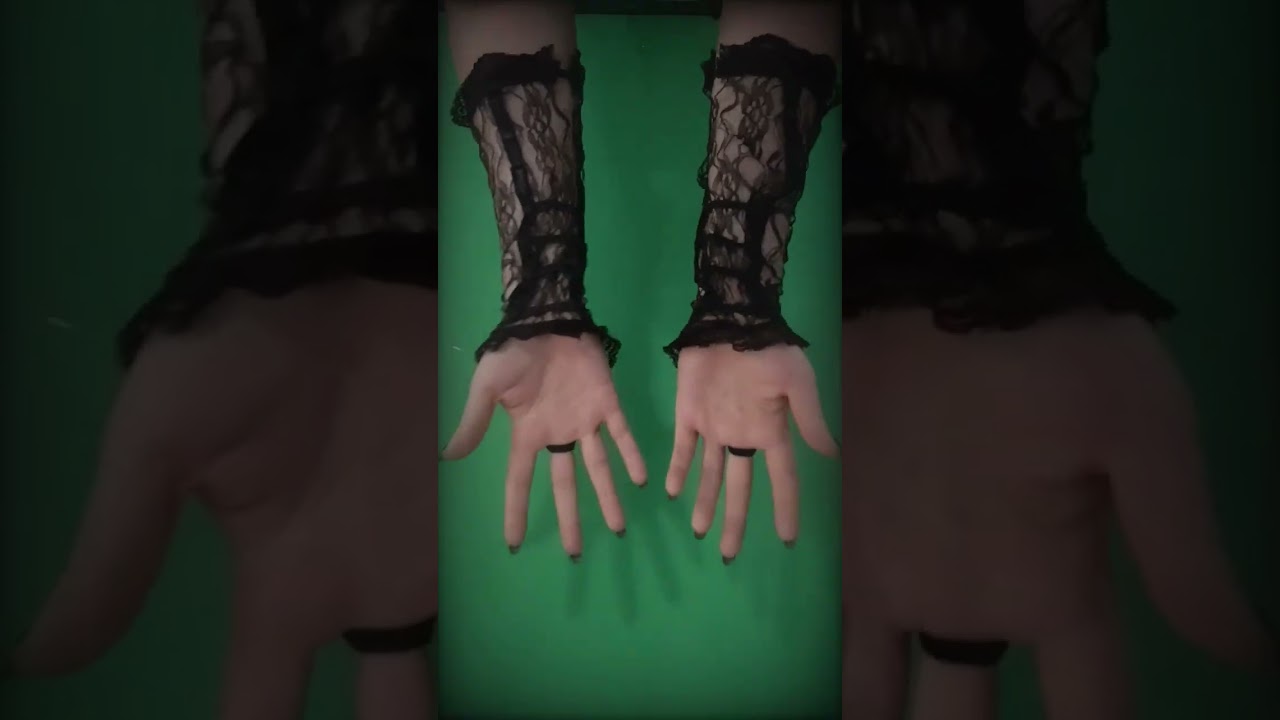Gothic lace fabric is a mesmerizing textile that exudes an air of dark romance and ethereal beauty. With its intricate patterns and delicate craftsmanship, this fabric is a testament to the artistry and creativity of Gothic fashion. Whether you're a lover of all things goth or simply appreciate the unique allure of lace, this fabric is sure to captivate your senses. The lace itself is meticulously woven, showcasing exquisite details that are both intricate and hauntingly beautiful. The delicate web of threads creates an enchanting effect, reminiscent of a spider's gossamer web, adding an element of mystique to any garment or accessory it adorns. The Gothic aesthetic is brought to life through the lace fabric, evoking a sense of dark elegance and Victorian-inspired decadence. Whether used in clothing, home decor, or costume design, this fabric adds a touch of gothic sophistication to any project. Immerse yourself in the allure of gothic lace fabric, and let your imagination run wild as you explore the possibilities of this enchanting material.

Gothic Lace Fabric: A Mystical and Alluring Textile
Gothic lace fabric is a captivating and mysterious textile that has been associated with the dark and romantic aesthetics of the gothic subculture. With its intricate patterns, delicate texture, and rich historical background, this fabric has become an essential element in gothic fashion and design. In this article, we will delve into the origins, characteristics, and uses of gothic lace fabric, shedding light on its enduring appeal in contemporary society.
The Origins of Gothic Lace Fabric
The origins of gothic lace fabric can be traced back to the late medieval period in Europe. Lace-making techniques were first developed in the 15th century, and the art of lace production quickly spread throughout Europe. However, it was during the Victorian era that lace reached the height of its popularity, becoming a symbol of wealth and sophistication.
Throughout history, lace has been associated with various cultural and religious practices. It has been used to adorn clothing, religious vestments, and even household items. In the gothic subculture, lace is often seen as a representation of elegance, darkness, and beauty.
Characteristics of Gothic Lace Fabric
Gothic lace fabric is characterized by its intricate and delicate patterns, which are often inspired by nature, religious symbolism, and gothic architecture. The fabric is typically made from fine threads, such as silk or cotton, which are woven together to create the lace pattern. The use of black or dark-colored threads gives the fabric its gothic appeal.
One of the most distinctive features of gothic lace fabric is its transparency. The delicate nature of lace allows light to pass through, creating a sense of ethereal beauty. This transparency also adds a layer of mystery and allure to the fabric, making it a popular choice for gothic fashion and accessories.
Uses of Gothic Lace Fabric
Gothic lace fabric is widely used in various aspects of gothic fashion, interior design, and even theatrical costumes. In gothic fashion, lace is often incorporated into clothing items such as dresses, blouses, and skirts, adding a touch of elegance and femininity to dark and edgy outfits.
Interior designers also utilize gothic lace fabric to create a hauntingly beautiful atmosphere in homes and establishments. Lace curtains, tablecloths, and decorative accents can transform any space into a gothic-inspired haven, evoking a sense of mystery and enchantment.
Theatrical productions and costume designers frequently turn to gothic lace fabric to create dramatic and visually striking costumes. Whether it's for a gothic-themed play, a vampire-inspired film, or a haunted house attraction, gothic lace fabric adds an element of authenticity and grandeur to the costumes.
Contemporary Interpretations of Gothic Lace Fabric
While gothic lace fabric has its roots in historical traditions, it has evolved and adapted to contemporary fashion and design trends. Designers today experiment with different colors, patterns, and textures, giving gothic lace fabric a modern twist.
Contemporary interpretations of gothic lace fabric often incorporate elements of punk, grunge, or alternative styles. This fusion of different subcultures creates a unique aesthetic that appeals to a wider audience. Gothic lace fabric can now be seen in a variety of colors, including deep purples, dark blues, and even vibrant reds.
In addition to clothing and interior design, gothic lace fabric has also made its way into the world of accessories. Lace chokers, bracelets, and hair accessories have become popular choices for those who want to embrace gothic fashion without going all out.
The Enduring Appeal of Gothic Lace Fabric
Gothic lace fabric continues to captivate and inspire designers, artists, and enthusiasts alike. Its timeless beauty, intricate craftsmanship, and association with the gothic subculture have made it an enduring symbol of elegance and darkness.
Whether it's a gothic-inspired wedding dress, a gothic-themed room, or a gothic fashion statement, gothic lace fabric adds a touch of mystique and allure to any creation. Its ability to evoke emotions and transport individuals to a different time and place is what makes it truly special.
In conclusion, gothic lace fabric is not just a textile; it is a piece of art that tells a story. Its rich history, ethereal beauty, and versatility have ensured its place in gothic fashion and design for centuries to come. So, embrace the darkness and let gothic lace fabric weave its magic into your life.
“Revamp Your Style: DIY Gothic Lace Gloves for a Touch of Elegance”
Gothic Lace Fabric:
Gothic Lace Fabric
Gothic lace fabric is a stunning and intricate textile that has captivated fashion enthusiasts for centuries. With its delicate patterns, intricate design elements, and dark allure, gothic lace fabric adds an air of mystery and elegance to any garment it adorns. Let's explore some fascinating details about this exquisite fabric:
| Feature | Description |
|---|---|
| Origin | Gothic lace fabric originated in the 16th century during the Gothic period in Europe. It was heavily influenced by architectural motifs, such as pointed arches and intricate tracery patterns found in Gothic cathedrals. |
| Material | Gothic lace fabric is traditionally made using fine threads of cotton, silk, or sometimes even metallic fibers. The delicate nature of the fabric allows for intricate detailing and creates a beautiful contrast against the skin. |
| Design | The design of gothic lace fabric is characterized by its elaborate patterns, often featuring motifs like roses, thorny vines, skulls, and crosses. These dark and romantic elements embody the gothic aesthetic, creating a unique and captivating appeal. |
| Usage | Gothic lace fabric is commonly used in the creation of gothic-inspired clothing and accessories. It is particularly popular in the design of Victorian-era-inspired dresses, gothic corsets, gloves, veils, and even home decor items like curtains or tablecloths. |
| Care | Due to its delicate nature, gothic lace fabric requires special care to maintain its beauty and longevity. It is recommended to hand wash garments made from this fabric or use a gentle cycle with mild detergent. Additionally, it should be air-dried or laid flat to prevent stretching or damage. |
| Modern Influences | Gothic lace fabric continues to inspire modern fashion designers, who incorporate its dark elegance into contemporary collections. It has also found its way into alternative subcultures, such as goth, steampunk, and Victorian-inspired fashion. |
Overall, gothic lace fabric is a timeless and enchanting textile that adds a touch of romanticism and sophistication to any garment or decor item. Its intricate designs and rich history make it a favorite among those who appreciate the allure of the gothic aesthetic.

